This article has been reviewed according to Science X's editorial process and policies. Editors have highlighted the following attributes while ensuring the content's credibility:
fact-checked
peer-reviewed publication
trusted source
proofread
Investigating adaptive strategies of high and low nucleic acid prokaryotes

A research team conducted a 73-day large-volume Aquatron macrocosm experiment, utilizing flow cytometry and dilution experiments to thoroughly investigate the temporal changes and influencing factors in the abundance, growth rate, and mortality of high nucleic acid (HNA) and low nucleic acid (LNA) prokaryotes, and the resulting carbon flow dynamics within the microbial loop. They explored the adaptive strategies of these microbial subgroups in response to declining resource availability and selective grazing by protozoa.
The paper is published in the journal Science China Earth Sciences, and the research was led by Dr. Nianzhi Jiao and Dr. Dapeng Xu from the College of Ocean and Earth Sciences at Xiamen University.
Results indicated that during resource-replete conditions, HNA prokaryotes exhibit higher metabolic activity compared to the LNA subgroup. However, as resources become scarce, the abundance of the HNA subgroup declines rapidly, leading to a steady increase in the relative contribution of LNA subgroup to overall prokaryotic activity.
Additionally, the study highlights that selective grazing by protozoa shifts from the HNA to the LNA subgroup as resource availability decreases, with the contributions of the LNA subgroups to the carbon flow within the macrocosm increasing from 9% to 16%.
The findings underscore the critical role of LNA subgroup in maintaining carbon flow and ecosystem stability during periods of low resource availability and illuminate the importance of protozoa's adaptive grazing behavior in maintaining a balance between the HNA and LNA subgroups and ensuring the continuous functioning of the microbial loop. This comprehensive analysis of the interplay between prokaryotic subgroups and protozoa provides insights into the adaptive mechanisms of microbial communities and their implications for marine biogeochemical cycles.

More information: Chen Hu et al, Adaptive strategies of high and low nucleic acid prokaryotes in response to declining resource availability and selective grazing by protozoa, Science China Earth Sciences (2024). DOI: 10.1007/s11430-023-1326-2
Journal information: Science China Earth Sciences
Provided by Science China Press




















